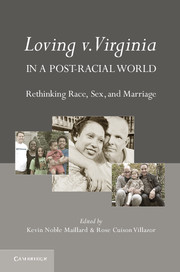Book contents
- Frontmatter
- Contents
- About the Contributors
- Acknowledgments
- Foreword
- Introduction Loving v. Virginia in a Post-Racial World
- Part One Explaining Loving v. Virginia
- Part Two Historical Antecedents to Loving
- Part Three Loving and Interracial Relationships: Contemporary Challenges
- Part Four Considering the Limits of Loving
- Part Five Loving Outside the U.S. Borders
- Part Six Loving and Beyond: Marriage, Intimacy, and Diverse Relationships
- Permission Granted
- Index
- References
Foreword
Published online by Cambridge University Press: 05 July 2012
- Frontmatter
- Contents
- About the Contributors
- Acknowledgments
- Foreword
- Introduction Loving v. Virginia in a Post-Racial World
- Part One Explaining Loving v. Virginia
- Part Two Historical Antecedents to Loving
- Part Three Loving and Interracial Relationships: Contemporary Challenges
- Part Four Considering the Limits of Loving
- Part Five Loving Outside the U.S. Borders
- Part Six Loving and Beyond: Marriage, Intimacy, and Diverse Relationships
- Permission Granted
- Index
- References
Summary
On or about June 12 each year since 2004, Loving Day – “an educational campaign and a global network of annual celebrations” – holds a “Flagship Celebration” in New York City to commemorate the anniversary of the Supreme Court’s ruling in Loving v. Virginia. In 2009, according to the website Blended People of America, the sixth annual Loving Day celebration in New York City “saw the gathering of about 1,100 people.… From 3 to 7 pm, guests mingled, heard and exchanged stories, danced to music, looked over the riverfront, created artwork, or gathered as families in a warm and welcoming environment.”
Loving Day presents itself as a quintessentially post-racial celebration. The Loving Day organizers, and their website, look back respectfully and gratefully to the Lovings, whose legal struggle made it possible for Americans of different racial identities to dance, marry, kiss, form families, and celebrate beauty, pleasure, and desire without fear of police or prisons. Now, in the new fluid reality that Loving Day celebrates, even the concept of “miscegenation” has begun to seem bizarre and antiquated. The very idea of race mixing assumes that there is purity to be lost. The “blended people” who come together for Loving Day, however, represent themselves as already various – each a tapestry of ethnicities, religions, racial identities, and cultures. Mixing, in this new context, does not represent a falling-away from purity and strength. Instead, mixing takes on a postmodern meaning. Loving Day celebrants see their mixed backgrounds as making possible deep, complex, rich identities layered with history, custom, and meaning, in the way that a deejay mixes beats, melodies, and rhythms to make deep, rich, funkier layers of sound.
- Type
- Chapter
- Information
- Loving v. Virginia in a Post-Racial WorldRethinking Race, Sex, and Marriage, pp. xv - xviiiPublisher: Cambridge University PressPrint publication year: 2012
References
- 2
- Cited by

